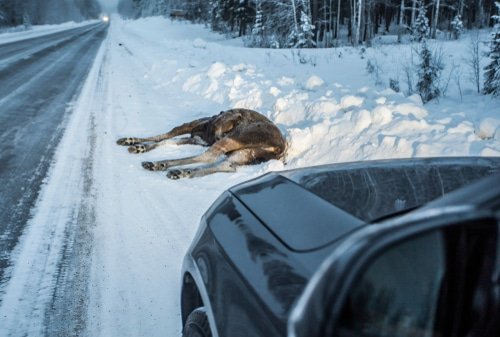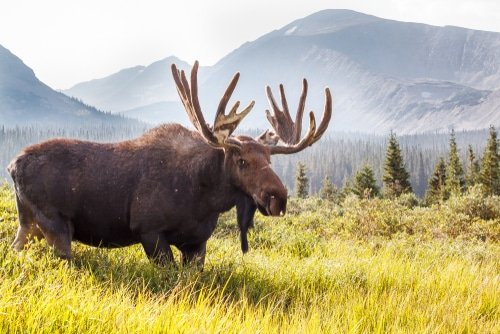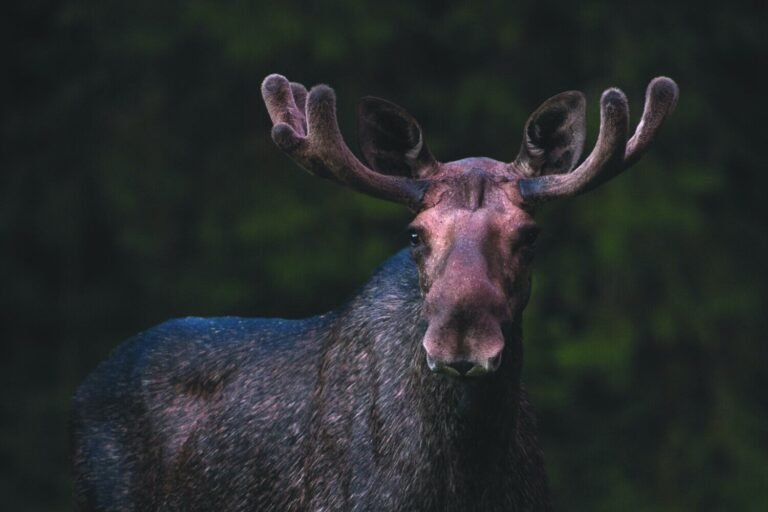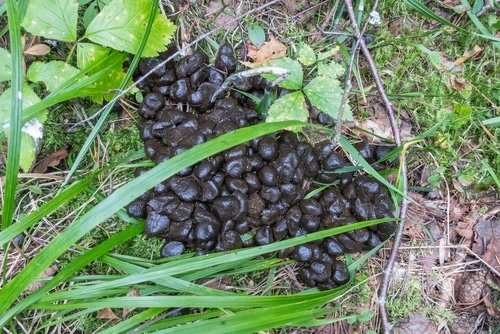Regarding wildlife photography, capturing moose’s majestic and awe-inspiring beauty in their natural habitat can be an incredibly rewarding experience. Moose, the largest members of the deer family, are truly remarkable creatures with their towering antlers and imposing size. They possess an undeniable charisma that lures photographers from all around the world. In this blog we will review our moose photography tips for better image creation.
The mere sight of a moose gracefully moving through its environment creates a magical moment that begs to be captured through the lens. These incredible animals offer photographers a unique opportunity to capture their physical grandeur and subtle expressions in stunning detail.
Importance of Understanding Moose Behavior and Habitat
To truly excel in moose photography, it is crucial to gain a deep understanding of their behavior and preferred habitats. Unlike other wildlife species, moose inhabit specific areas such as dense forests, wetlands, or meadows near water sources.
Understanding their preferred habitats allows photographers to narrow potential locations for successful encounters. Furthermore, comprehending moose behavior provides valuable insights into predicting their movements or reactions in different situations.
This knowledge enhances your ability to capture compelling photographs and ensures your safety while photographing these magnificent creatures in the wild. By immersing ourselves in the world of moose and learning about their behaviors and habitat preferences, we lay a solid foundation for successful encounters with these majestic creatures to capture breathtaking images that tell captivating stories within each frame.
Choosing the Right Camera and Lenses for Moose Photography
Capturing the majestic beauty of moose in the wild requires the right equipment, starting with your camera. When photographing moose, a camera with a high-resolution sensor and good low-light performance is crucial. Opt for a DSLR or mirrorless camera that allows you to adjust manual settings and capture RAW images to maximize post-processing options.
In terms of lenses, versatility is key. A telephoto lens with a focal length of at least 200mm will allow you to capture close-up shots while maintaining a safe distance from these magnificent creatures.
A zoom lens with a wider range, such as 70-300mm or 100-400mm, provides flexibility when composing different shots in various situations. This way, you can capture intimate details and stunning landscapes without constantly switching lenses.
Tripods and Stabilizers for Steady Shots in the Field
Stability is crucial to ensure sharp images while photographing moose in their natural habitat. Investing in a sturdy tripod will provide the necessary support for your camera setup. Look for tripods made from lightweight materials like carbon fiber that are easy to transport yet robust enough to handle different terrains.
In addition to tripods, consider using stabilizers like monopods or bean bags for more versatility when shooting on the go. These handy tools help reduce camera shake while allowing freedom of movement—perfect when you need quick adjustments while keeping your gear steady.
Essential Accessories like Lens Hoods, Filters, and Remote Shutter Release
When photographing moose in their natural environment, it’s crucial to be prepared with essential accessories that enhance image quality and protect your gear. Lens hoods are vital as they prevent lens flare and reduce the risk of damage from accidental knocks or bumps.
Filters play an important role in wildlife photography by controlling light and enhancing colors. Consider using a polarizing filter to minimize glare on water surfaces, as moose frequently inhabit wetland areas.
Additionally, neutral density filters can be useful for balancing exposure in bright lighting conditions. A remote shutter release is a handy tool that allows you to trigger your camera without touching it.
This minimizes any potential movement caused by pressing the shutter button, resulting in sharper images. It’s especially beneficial when shooting with longer exposure times or utilizing techniques like time-lapse photography.
Finding Moose Hotspots
Researching moose habitats and migration patterns
If you want to up your game in photographing moose in the wild, doing your homework is crucial. Start by researching moose habitats and understanding their migration patterns. Moose prefer areas with abundant vegetation, such as wetlands, meadows, or forests near water sources.
They are also known to migrate between different areas depending on the season. By familiarizing yourself with their preferred habitats and migration routes, you can increase your chances of encountering these magnificent creatures.
Tips for scouting locations with higher chances of spotting moose
While it’s true that moose can be found in various regions across the globe, some locations offer better opportunities for wildlife photography than others. Look for places known for their dense moose populations, such as national parks or wildlife reserves, where conservation efforts have been successful.
These areas often have dedicated trails or observation points specifically designed for wildlife enthusiasts like yourself. Additionally, watch for signs of recent moose activity, like fresh tracks or browsing marks on trees – these are indicators that you’re in a promising area.
Utilizing local knowledge or hiring a guide for better results
Local knowledge is invaluable when it comes to finding the best spots for photographing moose. Locals who live near known moose habitats are well-acquainted with the behavior and movements of these majestic creatures.
Engage with them by striking up conversations at local cafes or visitor centers – they may offer insider tips on prime shooting locations that aren’t widely known. Alternatively, consider hiring a professional guide who specializes in wildlife photography tours.
These experienced individuals possess an extensive understanding of animal behavior and know precisely where to find these elusive animals at different times of the year. A skilled guide can enhance your chances of capturing breathtaking moose photographs and ensure your safety and compliance with wildlife regulations.
Remember, patience and persistence are key when searching for moose hotspots. Studying their habitats, scouting locations, and tapping into local expertise will greatly enhance your chances of encountering these magnificent creatures and capturing remarkable images in the wild.
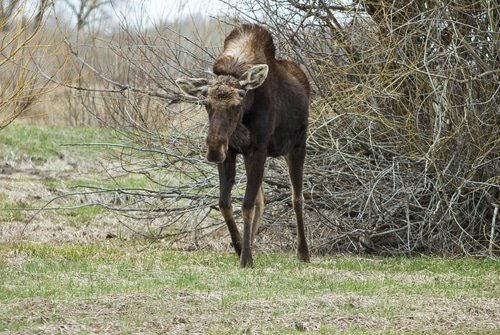
Understanding Moose Behavior
Learning about rutting season and its impact on moose behavior
Rutting season, also known as the mating season for moose, is a crucial time to understand their behavior. It usually occurs in the fall, when male moose become more aggressive and territorial.
During this time, they engage in fierce battles to establish dominance and win over potential mates. Understanding rutting behavior is essential for wildlife photographers as it allows them to capture dramatic moments of male moose displaying their strength and antlers.
It’s important to remember that during rutting season, males can be particularly unpredictable and prone to aggression. Therefore, keeping a safe distance while observing and photographing them becomes paramount.
Recognizing signs of aggression or stress to maintain safety while photographing moose
Safety should always be a top priority when venturing into the wild for wildlife photography. While photographing moose, it’s crucial to recognize signs of aggression or stress exhibited by these majestic creatures. Displaying raised hackles, bared teeth, and lowered heads with ears laid back all indicate potential aggression from a moose.
Additionally, suppose you notice a moose repeatedly licking its snout or showing signs of nervousness like constant head turning or flaring nostrils. In that case, it may be feeling stressed or uncomfortable with your presence. In such cases, it’s best to slowly back away and give the animal ample space.
Patience is key: Observing their feeding, mating, or resting habits.
Capturing stunning photographs of moose requires patience and an understanding of their natural behaviors. Observing their feeding patterns can lead you to prime locations where they frequently gather for nourishment. Moose generally prefer aquatic plants like water lilies or willows growing near ponds and swamps; these areas often provide excellent opportunities for capturing their interactions with the environment.
Learning about their mating rituals and resting habits can help you anticipate and capture unique moments. Patience is key to wildlife photography, as it allows you to be present in the right place at the right time, ready to capture those breathtaking moose shots in their natural habitat.
Composition Techniques for Moose Photography
Capturing the majestic size and antlers of male moose
When photographing moose, one cannot ignore the sheer magnificence of a male moose with its impressive antlers. To capture their grandeur, it’s crucial to consider your composition.
Ensure the moose occupies a significant portion of your frame, emphasizing their size and presence. Position yourself at eye level with the moose whenever possible to showcase their power and dominance.
Experiment with different focal lengths to find the optimal balance between capturing the entire body and highlighting the details in their antlers. Remember, getting closer isn’t always possible or safe, so telephoto lenses can help bring them closer while maintaining a safe distance.
Framing techniques to emphasize the natural surroundings
While capturing stunning images of moose, don’t forget about their habitat. Moose often roam in breathtaking landscapes such as dense forests or serene lakeshores. Use framing techniques to create compelling compositions that showcase both the subject and surroundings.
Look for natural elements like trees or foliage that can act as frames around your subject, drawing attention directly to the moose while adding depth to your image. Additionally, incorporating leading lines from rivers or trails can guide viewers’ eyes toward the magnificent creature amidst its natural environment.
Experimenting with different angles to highlight unique features
To truly capture unique and captivating images of moose, try experimenting with various angles and perspectives. Instead of always shooting from eye level or at a typical distance, challenge yourself to find new viewpoints that showcase distinct features or behaviors of these remarkable creatures.
Kneel low and shoot upwards to emphasize their towering stature against an expansive sky. Alternatively, get down on your belly for a ground-level perspective emphasizing details such as hoof prints in the dirt or water splashing around their legs as they wade through a lake.
You can unlock a whole world of creative possibilities in your moose photography adventures by exploring different angles. Remember, wildlife photography is a blend of art and storytelling.
Experimenting with composition techniques and angles will result in visually stunning images and provide viewers with unique perspectives on these majestic animals in their natural habitats. So grab your camera, venture into the wild, and embark on an unforgettable journey to capture the beauty of moose through your lens.
Camera Settings and Techniques
Adjusting Exposure Settings to Handle Contrasting Light Conditions
Understanding how to handle contrasting light conditions is crucial when capturing stunning moose photographs. Moose are often found in areas with diverse lighting, such as deep forests or open meadows.
To deal with this challenge, adjust your exposure settings accordingly. Try using a lower ISO setting and a faster shutter speed in bright sunlight to prevent overexposure.
On the other hand, in low light situations like sunrise or sunset, increase your ISO and consider using a tripod for longer exposures. By finding the right balance between highlights and shadows, you can capture the true beauty of these magnificent creatures.
Tips for Capturing Sharp Images While Dealing with Low Light Situations
Photographing moose during dawn or dusk can create breathtaking images but also present difficulties due to limited available light. To ensure sharpness in low light conditions, several techniques are worth considering.
Firstly, use a wide aperture (low f-stop number) to allow more light into your camera sensor while maintaining a shallow depth of field. This will help isolate your subject from the background while keeping the moose’s eyes and antlers in focus.
Secondly, brace yourself against a sturdy object or use a tripod to minimize camera shake during longer exposures. Additionally, utilizing image stabilization technology (if available) can significantly improve image sharpness when shooting handheld.
Exploring Creative Techniques Like Panning or Motion Blur
If you want to add an artistic touch to your wildlife photography by experimenting with motion blur or panning techniques while photographing moose in action, you should keep a few things in mind. With motion blur, please choose an appropriate shutter speed that allows some movement while retaining some definition of the subject’s features, like their legs or antlers.
This technique can convey a sense of energy and dynamism, especially when capturing moose running or jumping. On the other hand, panning involves tracking the movement of the moose with your camera as they move across your field of view.
By using a slower shutter speed and moving your camera in sync with the subject, you can create a sharp focus on the moose while blurring the background, giving a sense of movement and speed to your images. Incorporating these camera settings and techniques into your moose photography adventures will enhance your chances of capturing incredible shots.
Remember to adapt them based on the specific lighting conditions and desired creative effects you aim to achieve. By mastering these techniques, you’ll be able to showcase the beauty of the moose and your artistic vision in portraying these magnificent creatures in their natural habitat.
Dealing with Challenges in Moose Photography
Tackling Unpredictable Weather Conditions in Outdoor Shoots
Weather can be quite unpredictable when you are out in the wild, attempting to capture those stunning moose moments. One moment, the sun may be shining brightly, illuminating the majestic creature in all its glory, and the next moment, dark clouds may roll in with a vengeance.
To tackle such weather challenges during your moose photography escapades, it’s crucial to come prepared. Always wear rain gear to shield your precious camera equipment from unexpected downpours.
Additionally, consider investing in a sturdy and reliable camera cover or waterproof housing to ensure your gear remains safe and dry even amidst torrential rainstorms. Remember, while photographing moose in the wild is exhilarating, it’s essential to prioritize protecting your equipment from nature’s whims.
Handling Long Distances Between You and the Subject
One of the significant challenges photographers face when it comes to moose photography is dealing with long distances between themselves and their subjects. Moose are majestic creatures that roam freely across vast territories, often making them tricky to approach up close. However, you can employ a few techniques to overcome this challenge.
Firstly, invest in a good telephoto lens that allows you to zoom in on these magnificent animals without getting too close physically. A lens with a focal length between 200mm and 400mm should provide adequate reach for capturing impressive shots of distant moose.
Tips on Camouflage Techniques to Blend into the Environment
Mastering camouflage techniques is essential to truly immerse yourself into the world of wildlife photography and improve your chances of getting those stellar shots of moose up close and personal. By blending into the environment seamlessly like an elusive chameleon, you increase your chances of photographing these magnificent creatures without alarming or disturbing them. Opt for clothing in earthy tones like greens, browns, and grays that mimic the natural colors of the forest.
Avoid bright or flashy clothing that may startle the moose or draw undue attention. Additionally, consider using camouflage netting or blinds to conceal yourself further while waiting for that perfect shot.
Patience and stealth are vital when photographing moose in their natural habitat. Incorporating these strategies and techniques into your moose photography adventures will enhance your ability to tackle challenges such as unpredictable weather conditions, long distances from your subject, and blending seamlessly into the environment.
By embracing these methods, you can focus on capturing awe-inspiring images of these majestic creatures while respecting their habitats and ensuring their safety. So venture out with confidence, armed with your camera gear and a deep appreciation for the wonders of nature awaiting you in the world of moose photography!
Respecting Wildlife Ethics
Keeping a Safe Distance
When engaging in wildlife photography, it is crucial to maintain a safe distance from your subjects. This is especially true when photographing moose, as they are powerful and unpredictable creatures.
Approaching them too closely can lead to stress or even provoke aggressive behavior. It’s important to remember that we are guests in their natural habitat, and respecting their personal space ensures their well-being and our safety.
Minimizing Disturbance
As photographers, we have a responsibility to minimize our impact on the natural environment. When photographing moose, it’s essential to avoid causing unnecessary disturbance.
This means refraining from excessive noise, sudden movements, or disrupting their daily routines. Keeping disruptions to a minimum allows us to capture genuine and undisturbed behaviors that truly reflect the beauty of these magnificent creatures.
Preserving Habitat
Protecting the habitat of the moose is vital for their survival and the ecosystem’s overall health. Avoid trampling vegetation or venturing into sensitive areas that may cause damage.
Stay on designated trails whenever possible and respect any closures or restrictions by wildlife management authorities. By being mindful of our environmental impact, we contribute to preserving these habitats for future generations of both humans and wildlife.
Conclusion
Wildlife photography offers us a remarkable opportunity to connect with nature and capture awe-inspiring moments with creatures like moose in their natural habitats. By respecting wildlife ethics, such as keeping a safe distance, minimizing disturbance, and preserving habitat, we can ensure ethical practices while obtaining incredible shots. Remember that responsible wildlife photography benefits the animals and helps raise awareness about conservation efforts.
So grab your camera gear, head out into the wilderness with respect for nature’s wonders, and unleash your creativity to capture stunning images. Happy photographing!

